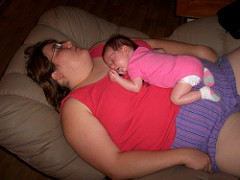As the name implies, Mixed Sleep Apnea is the combination of the two types of sleep apnea Obstructive Sleep Apnea (OSA) and Central Sleep Apnea (CSA). All three types of sleep apnea cause sleep deprivation and oxygen deprivation.
Obstructive Sleep Apnea occurs because of an obstruction in the air passage while an individual is sleeping, this obstruction can be caused when a tissue in the upper throat collapse and causes air to become blocked and breath is temporarily stopped. Eventually lack of oxygen causes the lungs to suck in air. In most cases this happens quickly and the individual doesn’t even realize a problem has occurred. However, a gasping or snorting sound may occur but the individual usually does not completely wake up.
There are certain factors that put individuals at risk for OSA. This factors include: excessive weight; neck circumference (more than 17 inches for men; more than 15 inches for women); high blood pressure; narrowed airway; chronic nasal congestion; diabetes; being male; being of African American, Hispanic; of Pacific Island heritage; elderly; family history of sleep apnea; use of alcohol, sedatives, or tranquilizers; and smoking.
Central Sleep disease is a neurological disorder, unlike Obstructive Sleep Apnea which is a physical disorder. With CSA the brain sends confusing signals to the respiratory system causing the breathing process to stop. The individual suffering from CSA will gasp for air to resume the breathing process.
There are certain factors that can put individuals at risk for developing central sleep disease. These factors include: being male; being diagnosed with congestive heart failure or atrial fibrillation; stroke or brain tumor; living at a high altitude; and taking certain medications that affect breathing. There are actually five types of CAS. Idiopathic central sleep disease; Cheyne-Stokes respiration; Medical condition induced apnea; High-altitude periodic breathing; and Drug or substance induced apnea.
Symptoms for all three types of sleep disease are the same: loud snoring accompanied by gasping and snorting sounds; abrupt awakenings with a shortness of breath; insomnia; excessive daytime sleepiness; and problems with concentration and memory.
All three types of sleep disease are dangerous, and an individual experiencing any of the above listed systems should seek medication attention. Left undiagnosed and/or untreated can lead to the following medical conditions: cardiovascular problems; daytime fatigue; and complications with medications and surgery.
All three types of sleep disease can be diagnosed by a sleep study test called polysomnography (PSG) which is conducted by sleep specialist at a sleep clinic. The PSG monitors the brain waves, eye movement, muscle activity, and heart rhythm of the patient. A patient is said to have sleep disease if the PSG test defines five or more episodes of apnea (pause in breathing) per hour. A couple of other tests are also useful in the diagnosis of sleep disease. Oximetry screening can also be conducted. This is a screening method that monitors and records an individual’s blood oxygen level during sleep. Portable cardiorespiratory testing is also an option. This is a test that is conducted at home to diagnosis sleep disease.
Go to Sleep Apnea Zone to get your free ebook on Sleep Apnea at Sleep Apnea. Sleep Apnea Zone also has information on Mixed Sleep Apnea along with a lot of other free information. Come by our new Sleep Apnea Community site today for free ebooks and other free information that can help you today.

